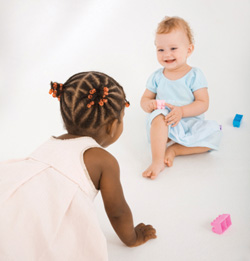
Five-year-old Kayleigh is showing her grandma around her kindergarten classroom. With obvious pride, she points out her photo on the attendance board, the soupy aquariums brimming with salmon eggs, the cozy and well-stocked reading nook. Then she points out her very best new friend, Maya, a gorgeous black child of Ugandan and Jamaican heritage. “That’s her, over there,” says Kayleigh, who is white. “That girl — the one with the black hair.”
Kayleigh is my daughter, and until about a month ago, I had thought of that incident as evidence of a brilliant parenting success: My child doesn’t see skin color! Indeed, that’s how it seemed to my mother, too, who recounted the incident to me later. “I thought it was neat that she was identifying this child by the color of her hair and her position in the room, and not the color of her skin,” she says.
It turns out, well-meaning though I was, I was making an all-too-common mistake: letting my child form her opinions about race in a vacuum. “Everyone is equal,” I repeatedly told my very young children. “Treat all people the same, regardless of skin color.”
 But increasingly, research shows that that sort of implicit “color blind” approach doesn’t go nearly far enough towards growing egalitarian belief systems in children. That’s because scientists now know that the human brain simply cannot perceive all people as the same. In fact, a growing body of research suggests that human beings are born to discriminate; born to notice differences between people and then categorize them accordingly.
But increasingly, research shows that that sort of implicit “color blind” approach doesn’t go nearly far enough towards growing egalitarian belief systems in children. That’s because scientists now know that the human brain simply cannot perceive all people as the same. In fact, a growing body of research suggests that human beings are born to discriminate; born to notice differences between people and then categorize them accordingly.
There is no getting around it: Skin color is plainly visible. A child’s brain will notice skin color. Does this mean we are born to be racist?
“No, we aren’t necessarily born racist,” says Jason Marsh, editor of the new book Are We Born Racist?, “but we are born with a certain predisposition to fear that which we deem to be unlike us somehow. We are born with a predisposition to group people into categories. That doesn’t necessarily mean that you are going to link that difference to any type of inferiority. What matters is what kids learn implicitly or explicitly about what those differences mean.”
“The brain cannot be antiracist, per se,” writes New York University professor David Amodio in Are We Born Racist?, “because it never stops spotting differences and sorting people into categories. But it is pro-goal — and if the goal is to make judgments without regard to race, the brain can do that, though it may take a bit of effort and practice.”
The good news? Though we are wired to notice differences, we are also wired for fairness, scientists say. What is called for now is a new approach to discussing race with children.
The myth of color blindness
So, what’s so wrong with the old “color blind” idea? Many experts now believe it completely misses the point. “We really thought that the way to address racism was to act like there were no differences between us, and to just have everybody hold hands and sing ‘Kumbaya’ and think we were done,” says Joan Cole Duffell, executive director of Committee for Children (CFC), a nonprofit that develops cultural-literacy curricula. “The way we look at it now: ‘You know what? Kids are born being able to discriminate.’ . . . We’ve flipped our notion from ‘Let’s act like there are no differences’ to ‘Let’s call out differences and learn to appreciate the beauty of them.’”
Instead of ignoring racial differences, parents should call them out explicitly and discuss them — just like they do with other differences, says Po Bronson, co-author with Ashley Merryman of NurtureShock: New Thinking About Children. “When you’re reading a picture book to a 1-year-old, you say, ‘Look at the yellow jacket! Look at the red truck!’ But the pictures of the kid who has pinkish skin and the kid who has brownish skin? We never mention it. I’m thinking, ‘What are we passing on to our kids?” Bronson writes in NurtureShock, “We tell kids that ‘pink’ means for girls and ‘blue’ is for boys. ‘White’ and ‘black’ are mysteries we leave them to figure out on their own.”
And figure it out they do, in the absence of parental specificity. “Children think we’re crazy when we say, ‘We’re all the same.’ We’re not!” says Julie Olsen Edwards, a veteran teacher and the co-author of Anti-Bias Education for Young Children and Ourselves. “Children are absolutely marvelous observers of people — they really look at people and they know we look different. And when the grownups who spend hours teaching them how to say ‘pink’ and ‘purple’ and ‘orange’. . . when we won’t talk about the fact that people look different, we teach children to be afraid of the subject.”
The ‘in’ crowd
Besides being hard-wired to notice differences, children are naturally inclined to gravitate towards the familiar and similar. Scientists call this “in group” and “out group” preferences, and, in the absence of other input, kids will choose in-group peers almost every time.
Bronson cites research by Rebecca Bigler at the University of Texas in which preschoolers were given T-shirts to wear to school for three weeks. The distribution was random; half were given blue shirts and half were given red. During the experiment, the teachers never discussed the T-shirts or sorted the kids by shirt color in any way.
The kids didn’t divide themselves by shirt color, either, but when asked which color was better, they chose their own, saying that people with their color shirt were “smarter” and “better” than the others. “Bigler’s experiment seems to show how children will use whatever you give them to create divisions,” writes Bronson. “Even if no teacher or parent mentions race, kids will use skin color on their own, the same way they use T-shirt colors.”
This effect has real-life resonance in the schoolhouse. According to an Ohio State University study, the odds of a teen naming someone of the same race as a friend are about twice the odds of naming a friend from a different race. And surprisingly, the study also showed that the likelihood of segregated friendships actually increased as a school's racial diversity moved from moderately low to moderately high.
“When you get larger minority populations, they reach a size where you can have a viable single-race community," researcher James Moody writes in the study. “At that point, students find enough friends within their own race and don't tend to make cross-racial friendships.
“Simply exposing students of different races to each other may not promote integration. If you walk in the lunchroom and all the black kids are on one side and all the white kids are on the other, they are living in separate worlds. There have to be specific practices that help overcome the tendency for people to self-segregate.”
“We were really shocked to learn that the silence about race carried into schools, such that school diversity wasn’t accomplishing goals,” says Bronson. “Without talking about racial issues — without condemning extensive self-segregation — as schools get more diverse, you don’t necessarily have more cross-racial friendships.”
 Why it matters
Why it matters
Why do cross-racial friendships matter? We all want to raise children who are free from racial bias. But there are other compelling reasons why parents should directly address issues of race with their children. “Living in an increasingly diverse society — in any kind of multi-ethnic society — if you hold intolerant beliefs or are fearful of the ‘other,’ that is going to be deeply stressful,” says Marsh. “Research suggests that that kind of stress can take a toll on your psychological and physical health.”
In fact, numerous studies have shown that racially prejudiced people suffer acute physical stress reactions when interacting with people of another race; their stress hormones spike, blood vessels constrict, and hearts pump harder. In one study by Elizabeth Page-Gould of the University of Toronto, European-Americans were paired up with partners, either black or white, and told to share personal information. Stress levels were tested before and after the interaction by measuring the stress hormone cortisol in the participants’ saliva. The study found that white people who scored high on a measure of automatic prejudice — the degree to which they associate certain ethnic groups with “good” and “bad” — had spiked levels of cortisol after a friendly cross-race interaction. Other studies have also shown a release of DHEA-S, the hormone that usually spikes in the wake of a “flight or fight” reaction. Over time, this kind of response wears on the heart and can damage the immune system.
Also, Marsh says, egalitarian people tend to have more successful careers. “In classroom settings and workplaces, if you’re going to be in any kind of diverse environment, if you can help people see their commonalities rather than their differences, they are going to perform a lot better,” he says. “If you are raising kids who are going to be part of a diverse workforce, it’s really important for their economic security to be able to work with people who are different.”
“Your kids are going to be in the world,” agrees CFC’s Joan Cole Duffell. “They’re 21st century kids, and they are, by default, global citizens. Your kids are going to be working in teams with people from Dubai. They have to be culturally competent. If not, they are actually going to be at a deficit.”
What can parents do?
Groups like Committee for Children and The Reach Center work to increase cultural competency by creating school curricula that prompt rich discussion around matters of race. But for egalitarian values to truly sink in, the message needs to begin at home. That’s a prospect many parents — especially white parents — find uncomfortable.
“Parents are often nervous about saying the wrong thing, or reinforcing prejudices, or making themselves seem intolerant unintentionally,” Marsh says, and this can lead to a kind of paralysis. “When adults feel uncomfortable — even if they hold really nonracist and egalitarian beliefs internally — when they are nervous about interacting with someone of a different race, the fear of coming across as racist will actually make them seem more prejudiced. It’s an ironic, negative effect.”
“Parents need to feel more comfortable talking about race, period,” says Allison Briscoe-Smith, Ph.D., a professor at the Pacific Graduate School of Psychology and contributor to Are We Born Racist?. Get in the habit of discussing race issues with your friends, she suggests. “Talk to other parents about ‘How do you talk to your kids about race?’ If I can engage in a conversation with other parents about gender issues, why not race, too?”
“Silence is a powerful teacher,” says Olsen Edwards. “What adults don’t talk about teaches children that adults are afraid, that the subject is dangerous. That leaves children to have to make up their own information, which is usually incorrect. It leaves children to the expertise of the 7-year-olds, 9-year-olds and 13-year-olds down the block.”
And, also, unfortunately, to the “expertise” of the media. “Our kids are surrounded with racist messages every minute,” says Olsen Edwards. “Parents have to be prepared to speak to that.” Olsen Edwards took her granddaughter to see the movie The Lion King. “When we came out, my granddaughter said, ‘Nana, I don’t like those brown people.’ That’s when I realized that all the bad characters are dark.
“Right now in children’s videos, you can always tell who the bad person is, because the bad person always has an accent. What is that teaching children about themselves and everybody else?”
Olsen Edwards says parents need to send a very clear message, beginning in infancy: Skin color doesn’t make a bit of difference to the kind of person that you are. Tell kids, “There are good, kind people who are dark and who are white, and mean people who are white and who are black,” suggests Olsen Edwards. Surround your child with books, dolls and videos that feature people with different colors of skin — and explicitly point out those differences. Tell them, “This is what human beings look like. They come in all different colors. Isn’t that beautiful?” Look for opportunities to point out differences in contexts kids will understand. Raising egalitarian kids takes consistent effort, more than many of us previously thought. “You kind of have to find your way through it,” says Bronson. “You have to use your kids’ interests; you have to use what’s around them. It’s a continuing process.
“My daughter is 6 now; she’s been hearing this stuff since she was 2 and a half,” says Bronson. “I give her the simplified version of it. I look for things that are relevant to her.” When Bronson’s daughter was younger, she was very much a princess, he says. Last year, when the Disney movie The Princess and the Frog came out, the fact that Princess Tiana is black was a topic of discussion, says Bronson. “Now she’s like, ‘It took them this long to have an African-American princess?’”
Tips for talking to children about race
With babies, find picture books with babies with different color skins. Explicitly point out the differences: “Smiling baby with beautiful chocolate skin! Laughing baby with creamy skin!” Offer dolls of different colors. Surround them with the message: “This is what human beings look like, with all different colors of skin. Isn’t that terrific?”
Tell toddlers, “Everybody’s got skin. It keeps our insides in! Skin colors come from our birth moms and dads. Names of skin colors are silly — no one is black and no one is white. ‘Black’ and ‘white’ are the names of big families of people from long ago. People whose families came out of Africa get called ‘black,’ and people whose families came out of Europe get called ‘white.’” Offer other names for skin color: mahogany, toffee, tan, cream, white-brown, toast.
Tell older kids, “We are all members of one race: the human race. But racial identity is absolutely real, and everybody has a racial identity.” Talk about how skin color doesn’t make a bit of difference to the kind of person you are. Tell them, “Sometimes people get treated badly because of the color of their skin or the shape of their eyes. In our family, we believe that is wrong.”
With teens, help them see that when things are unfair and wrong, they can make them right, and that people do that all the time. Discuss and model for your children the belief that people can take on unfairness and work to change it. Tell them, “That’s what people in our family do.” Make it explicit!
Source: Julie Olsen Edwards (julieolsenedwards.net)
Resources
Books
Are We Born Racist? New Insights from Neuroscience and Positive Psychology. Edited by Jason Marsh, Rodolfo Mendoza-Denton and Jeremy Adam Smith.
NurtureShock: New Thinking About Children by Po Bronson and Ashley Merryman
Anti-Bias Education for Young Children and Ourselves by Louise Derman-Sparks and Julie Olsen Edwards
Shades of People by Shelley Rotner and Sheila M. Kelly. A picture book about racial diversity for ages 4–8.
Black Is Brown Is Tan by Arnold Adoff. A story about an interracial family; ages 4–8.
Global Babies. A board book for babies by the Global Fund for Children.
Websites
The Greater Good Science Center at UC Berkeley — Podcasts, articles and more from the publishers of Are We Born Racist?.
A test that measures conscious and unconscious preferences, including racial prejudices, is available at https://implicit.harvard.edu/implicit.
Antiracist curricula Committee for Children — cfchildren.org
The Reach Center — reachctr.org
Teaching Tolerance — A project of the Southern Poverty Law Center; tolerance.org.
Teaching for Change — Includes a wonderful recommended reading list for children; teachingforchange.org.











